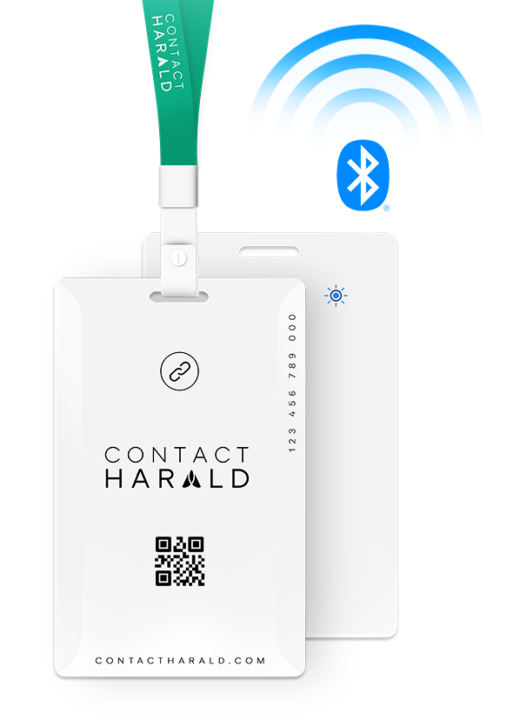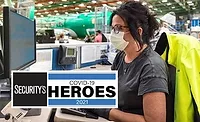New England College of Optometry implements contact-tracing wearables to boost COVID-response and enable in-person learning
The New England College of Optometry (NECO) formed a COVID-19 Task Force and began exploring ideas to enable in-person learning at the school in a safe, effective and well-planned manner. One of the solutions that NECO implemented is a contact-tracing tool that allows the school to respond immediately to report of an infection, accurately and effectively, without relying on a sign-in sheet or a person’s recollection of their previous contacts.

NECO’s teaching approach for future eye doctors relies heavily on students having live experiences, in-person classes and interactive learning. Once the COVID-19 pandemic became a reality and the Governor of Massachusetts ordered the state into a lockdown on March 17, 2020, NECO closed its facilities and quickly pivoted to a remote learning model. Image courtesy of NECO

The Contact Harald system consists of standalone Bluetooth badges that are worn by every student, staff and visitor while on the campus, providing NECO with elements of visual compliance, traceability, and accountability to avoid a campus-wide shutdown should an outbreak arise. Image courtesy of NECO
The New England College of Optometry (NECO) is a nationally recognized, top-tier optometry school located in Boston. Beyond its excellence in academic and clinical programs, the college provides support and mentoring to help students make a difference in their communities and the eye care profession.
NECO’s teaching approach for future eye doctors relies heavily on students having live experiences, in-person classes and interactive learning. Once the COVID-19 pandemic became a reality and the Governor of Massachusetts ordered the state into a lockdown on March 17, 2020, NECO closed its facilities and quickly pivoted to a remote learning model. Meanwhile, the school formed its COVID-19 Task Force and COVID Exposure Committees and began exploring ideas to enable in-person learning at the school in a safe, effective and well-planned manner, giving students a full academic experience and continuing toward graduation on-time while being fully prepared to practice optometry as their future profession.
The school took a “swiss-cheese” perspective to its pandemic response, according to Dr. Amy Moy, Chief Compliance Officer and Director of Health Center Network at NECO. As chief compliance officer, Dr. Moy is always putting safety as a top priority at NECO; while she usually directs compliance and health center eyecare in the clinical branch of NECO, her knowledge of infection control enabled her to take on the additional role of helping to enable in-person learning during the pandemic. Response protocols have included surgical-grade masks, hand-hygiene protocols, social distancing, foot traffic and space limitation management, screening questions for entrance, weekly COVID surveillance testing and contact-tracing cards.
“With significant planning, new tools and teamwork, we were able to welcome back clinicians to our eye care center and our students to a hybrid learning model in which they came to in-person laboratory courses and clinical rotations,” says Dr. Moy.
One of those solutions that NECO deployed in late August 2020 for the start of the fall semester and helped enable students and clinicians back for in-person learning was a wearable contact-tracing device for COVID-19 called Contact Harald. The Contact Harald system consists of standalone Bluetooth badges that are worn by every student, staff and visitor while on the campus, providing NECO with elements of visual compliance, traceability, and accountability to avoid a campus-wide shutdown should an outbreak arise.
NECO staff communicated with employees and students about the new technology and what to expect. “Each employee and student scheduled to be in person at the NECO campus was assigned their own card to be worn with their ID badge. Everyone was informed that their location was not being tracked and only proximity to other individuals with cards,” Dr. Moy explains. “Thus, if a positive COVID case arose, the card data would be uploaded to the system so that we can perform accurate contact tracing.”
The Bluetooth badges only track proximity between individuals without identifying location information. “Using Contact Harald’s services has been one of the vital tools that NECO has used to remain open during the COVID pandemic,” shares Dr. Moy. “We can more accurately and rapidly conduct contact tracing and respond with safety measures in minutes, not hours. The combination of putting necessary safety measures in place, like social distancing and mask wearing, with effective contact tracing, has been paramount to our ability to serve our students during this unprecedented time.”
In conjunction with the Bluetooth cards that students and staff wear, a mobile application that staff uses on iPads, register users and upload the data of a card holder who test positive. A cloud-based database only accessible by specific NECO staff, is used to contact trace individuals who have been in proximity during an infectious time period with someone who tests positive, allowing staff to pinpoint who should quarantine after exposure without guesswork.
Dr. Moy is proud to say that NECO has had no positive cases arising from in-person activities on campus, and the cards have performed well the few times they have needed to use them. The affected person remotely uploads their card data to a secure URL, where the data can be viewed and sorted on the school’s dashboard in order to pinpoint which close contacts had been within 6 feet for 15 minutes or more on certain days within the window of infection.
The Exposure Committee, which Dr. Moy chairs, manages each situation and sends out emails with guidance for next steps for travel, exposures, symptoms, etc.
“We are able to take action immediately and more accurately, no longer reliant on a sign-in sheet or an individual’s recollection of their close contacts,” Dr. Moy says.
The school has been so satisfied with adding a contact-tracing tool to its pandemic-response arsenal that it has already renewed the solution after its initial six-month battery life, and Dr. Moy says she expects that at the very least, small pockets of infection to trace may be around as a “new normal” for quite a while. But with the proper tools, there is a lot of hope and anticipation for the coming year.
This article originally ran in Security, a twice-monthly security-focused eNewsletter for security end users, brought to you by Security Magazine. Subscribe here.
Looking for a reprint of this article?
From high-res PDFs to custom plaques, order your copy today!








